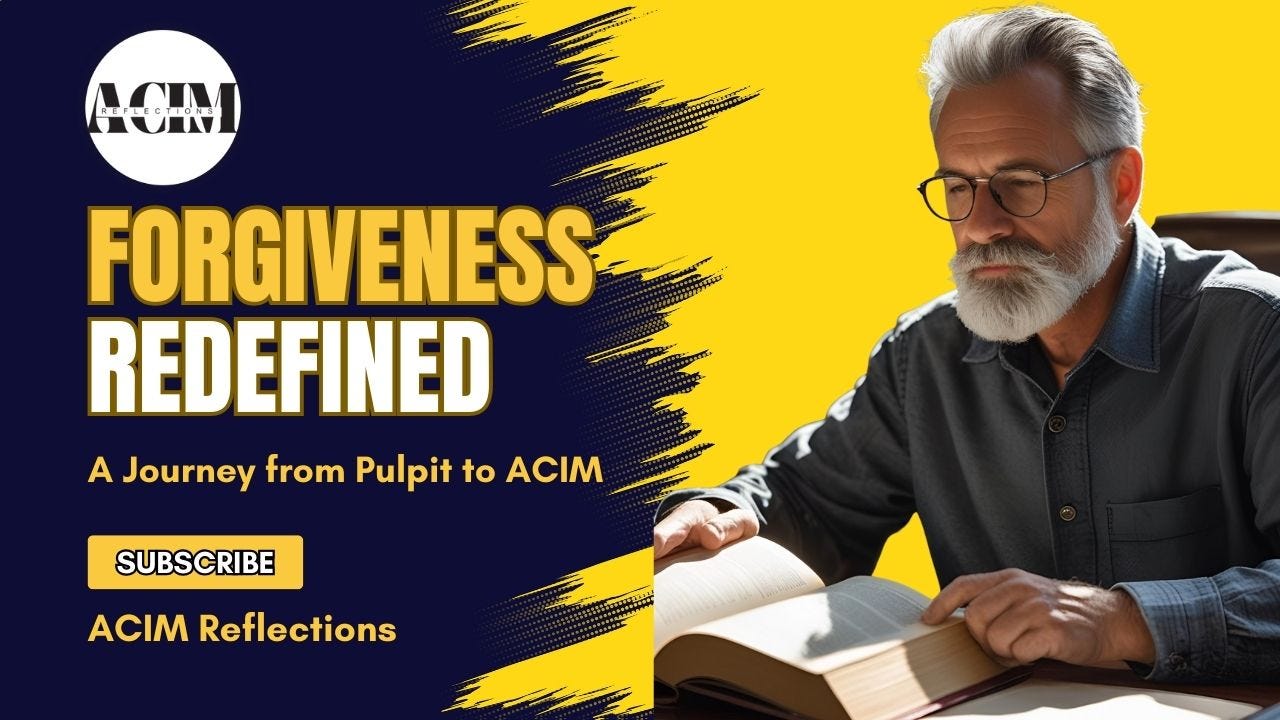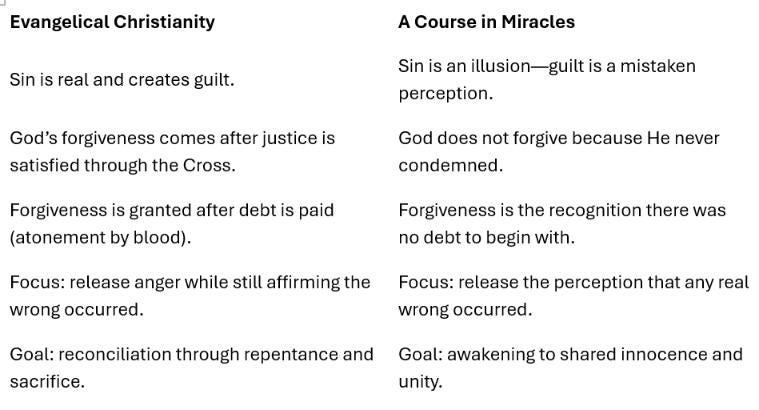What if forgiveness didn’t mean letting go of anger toward a real offense. What if it meant discovering the offense never happened?
From Guilt to Grace is a three-part journey that reexamines forgiveness, sin, and atonement through two very different lenses: evangelical Christianity and A Course in Miracles. I share how my understanding of key Christian doctrines has shifted through the lens of A Course in Miracles. In Part 1, I revisit forgiveness. In Part 2, I look at sin. And, in Part 3, I reflect on the meaning of atonement. Together, these reflections trace my journey from the pulpit of evangelical Christianity to the freedom of ACIM’s radical reframe: moving from guilt and sacrifice to awakening and peace.
I used to think forgiveness was a holy compromise.
You admit someone has wronged you, but—because you’re trying to be like Jesus, you grit your teeth, swallow your anger, and let it go. That was the forgiveness I preached from the pulpit for years.
But somewhere along the way, I began to notice a problem: even after “forgiving,” I was still holding the memory like a court record, ready to be pulled out as Exhibit A in my heart. It didn’t feel like freedom. It felt like parole.
That’s when A Course in Miracles walked in and quietly rewrote the meaning of the word entirely.
The Christian Understanding: Forgiveness Through the Shedding of Blood
In my pastoral days, I taught the standard evangelical view:
We retain the perception that another person has sinned against us and deserves our anger, but—because Christ commands it—we try to let go of that anger.
It’s baked into the liturgy. Every time I led Holy Communion, I would offer the bread and wine with these words:
“Take and eat, this is my body broken for you, and this is my blood shed for you for the forgiveness of sins.”
In evangelical theology, forgiveness is inseparable from the shedding of blood. The death of Jesus is the payment for humanity’s sins—the “atonement.”
The book of Hebrews says:
“Indeed, under the law almost everything is purified with blood, and without the shedding of blood there is no forgiveness of sins.” (Hebrews 9:22)
The sequence is clear: sin → punishment → forgiveness.
I realize, of course, that not all Christian theologians hold to this strict simplification. Back in my seminary days in the 1980s, I was surprised to discover that several of my professors quietly distanced themselves from the blood atonement doctrine. And yet, every Sunday, they still repeated the familiar words—“blood shed for your forgiveness”—as they served the Eucharist. Perhaps it was for the sake of tradition. Perhaps it was for job security. Either way, the ritual endured, even when the belief behind it was shifting.
But a deeper question lingered for me: Why would God need to sacrifice Himself in order to redeem His own creation? Why would love demand blood? I couldn’t shake the thought that if I, as an ordinary human being, can forgive someone without requiring violence or payment, then surely the God who is Love itself must be capable of even greater mercy.
“Forgiveness, at its highest level, needs no transaction at all.”
The ACIM Understanding: Forgiveness Without Condemnation
ACIM turns the formula upside down:
“God does not forgive, because He has never condemned.” (W-46.1)
If God never condemned, there’s no guilt to erase, no cosmic debt to settle. Forgiveness is not divine leniency—it’s divine recognition that the offense was never real in the first place.
In ACIM, we forgive not because sin has been punished, but because what we thought was sin was only a misperception. We’re letting go of illusions.
“Those who forgive are thus releasing themselves from the world of illusions, while those who withhold forgiveness are binding themselves to it.” (W-46.1)
This isn’t about denying that we feel hurt. It’s about seeing past the story of separation to the shared innocence beneath. Forgiveness becomes the way we free ourselves from the emotional chains we forged.
Two Views at a Glance
Closing Reflection:
For years, I thought forgiveness was something I gave to others—sometimes reluctantly, sometimes heroically. Now I see it’s something I give to myself, every time I drop the heavy storyline of who wronged me and why.
In the Christian model I preached, forgiveness was an act of obedience. In the ACIM model I live now, forgiveness is an act of awakening. One lets me go home at night feeling I did my Christian duty. The other lets me go home knowing I never left God’s peace in the first place.
And that, I’ve found, is the difference between being right about forgiveness and being free because of it.
Forgiveness is not a transaction, but an awakening to the innocence we never lost.
Series Description: From Guilt to Grace
From Guilt to Grace is a three-part journey that reexamines forgiveness, sin, and atonement through two very different lenses: evangelical Christianity and A Course in Miracles. As a former pastor turned ACIM student, I share how my understanding of these core doctrines has shifted—from sacrifice and guilt to awakening and grace. Each essay stands on its own, but together they invite reflection on what it means to release fear, dissolve guilt, and rediscover the peace that was never lost.




